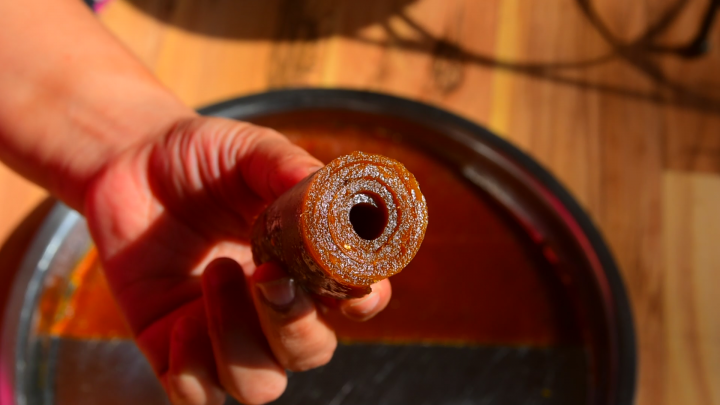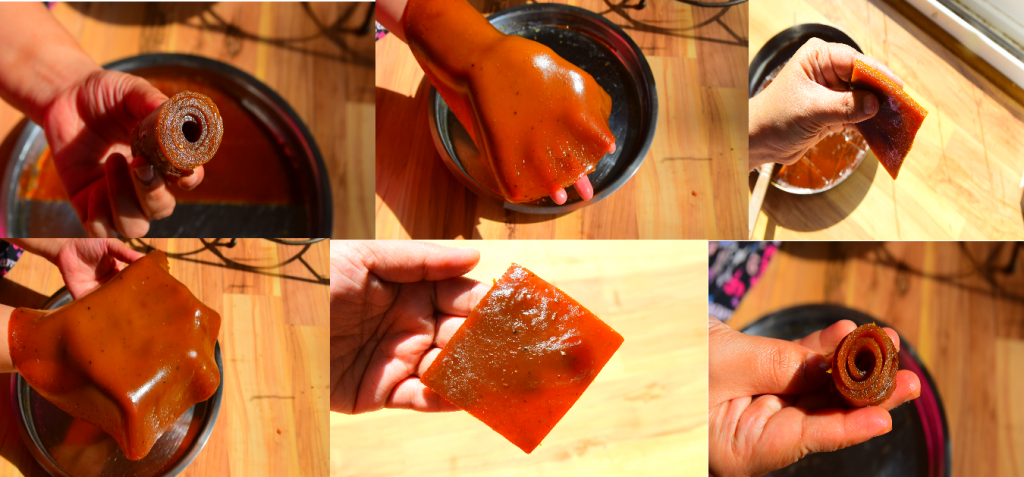Ambe Saati / Mango Papad brings back childhood memories. Aabu ghar (Maternal grandpa home) during the summer holidays would always be filled with Grand kids and MANGOES 🙂 And the best thing about my summer was to spend the entire day with my cousins on the terrace patrolling Variety of Papads made by my grandma, Ma and aunts. Especially, mango papads that we call ambe saati in konkani. Ambo is Mango in konkani and Saati means bar/jelly. So together “Ambe Saati”.
Mango Papad is traditionally sun dried for 2 or more days depending upon its thickness. The process of making mango papad at home may seem tedious.But,we all know store brought mango papads are made up of sugar which may also contain preservatives and added colors. Moreover, it cannot beat the taste of homemade mango saati 😉
To prepare this khatta meeta papad we can use any variety of mango. There are different types of mango papads made in different region. Here i have illustrated a simple mango papad that is made with jaggery and black pepper.See the complete recipe below.
Ambe Saati | Sundried Mango Jelly | Aam Papad

Mango papads are called "ambe saati" in konkani. Ambo means Mango in konkani and Saati means bar/jelly. So together "Ambe Saati". Mango Papad is traditionally sun dried for 2 or more days depending upon its thickness. The process of making mango papad at home may seem tedious.But,we all know store brought mango papads are made up of sugar which may also contain preservatives and added colors. Moreover, it cannot beat the taste of homemade mango saati 😉
Ingredients
- Ripe Mangoes - 4
- Jaggery - 2 blocks
- Black Pepper Powder- 1/2 tsp
- Salt
- Ghee for greasing
Instructions
1. Take 4 ripe mangoes. Wash & peel the skin of mangoes using a vegetable peeler.
2. Roughly chop mangoes and put in a mixer jar.
3. Cut the jaggery into small pieces.
4. Then blend the mango pieces to make a smooth puree. Do not add any water.
5. Strain the puree through a strainer into a thick bottom pan.
6. Add the jaggery to the strained mango puree and mix.
7. Now switch on the heat and mix the mango puree and jaggery on medium flame.
8. When Jaggery melts and combines with puree, we can see it changes in color and starts thickening.
9. Keep the flame at medium-low at this stage.
10. Add a little salt and freshly ground black pepper powder and mix.
11. Once it reaches a pouring thickness consistency, switch off the heat. (doesn't take more than 5 minutes after the jaggery melts)
12. Grease a plate with a little ghee. Pour the cooked mango puree onto the plate and spread evenly.
13. Keep the plates in the sun to dry.
14. The mango papads come out clean after drying thoroughly. Cut into the desired shape & size or make roll-ups! Enjoy homemade ambe saati guilt-free !!
Notes
- Instead of jaggery, sugar can be used as an alternative.
- If using raw mangoes then we may have to cook it first in water and then puree it. The remaining procedure is the same.
- Straining the mango puree gives a smooth texture to the papads discarding any fibers or bits.
- This version of papad is sweet, spicy and tangy. We can add different spices like cardamom, chilly powder, black salt and make as per our taste.
- Thin papads are spread thin on a plate and thick papads are spread thick. So the drying time of papads depends upon its thickness.
- Usually, thin papads can dry in Sun within 1 or 2 days. They are a little chewy and dry while eating.
- Whereas thick papads are juicy and sticky, more flavorful in my opinion 😉
Nutrition Information
Yield
20Serving Size
1Amount Per Serving Calories 47Total Fat 1gSaturated Fat 0gTrans Fat 0gUnsaturated Fat 0gCholesterol 2mgSodium 30mgCarbohydrates 10gFiber 1gSugar 9gProtein 1g
Nutrition Disclaimer: All information and tools presented and written within this site are intended for informational purposes only. I am not a certified nutritionist and any nutritional information on thebayindian.com should only be used as a general guideline. This information is provided as a courtesy and there is no guarantee that the information will be completely accurate. The nutritional labels are a product of online calculators such as Nutritionix. Even though I try to provide accurate nutritional information to the best of my ability, these figures should still be considered estimates. All content within this site is not intended as a medical diagnosis or treatment and should not be considered a substitute for professional medical expertise. If you think you have any type of medical condition, you should seek professional advice. Under no circumstances will thebayindian.com and its owner be responsible for any loss, adverse reactions, effects, consequences, damage, affliction or illness resulting in your reliance on the content here such as the recipes and nutritional information provided. Content should not be considered a substitute for professional medical advise, treatment or diagnosis. Should you need to be sure, please seek advice from a professional nutritionist or your doctor. This website, thebayindian.com, and its owner cannot be held responsible for any errors, omissions or inaccuracies published. This website, thebayindian.com, and its owner disclaim all liability or loss in conjunction with any content provided here. This website, thebayindian.com, and its owner disclaim any liability for products or services recommended on the site. The reader assumes full responsibility for consulting a qualified health professional regarding health conditions or concerns before using the content on this site. To obtain the most accurate representation of the nutritional information in any given recipe, you should calculate the nutritional information with the actual ingredients used in your recipe. You are ultimately responsible for all decisions pertaining to your health. By using thebayindian.com and its content, you agree to these terms.


Pingback: Ambe Humane/Upkari – TheBayIndian